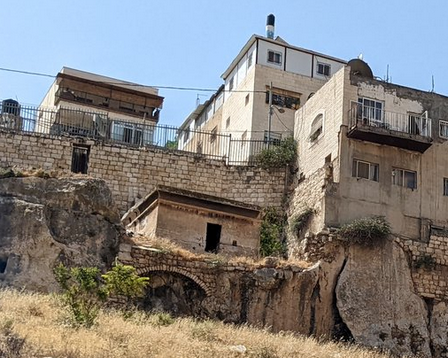Pharaoh's Daughter Lived Here

One of the first things King Solomon did when he ascended to the throne was to marry Pharaoh's daughter. In this way he made an alliance with Egypt and secured his southern border. Pharaoh conquered Gezer, exterminated its inhabitants and gave it as a wedding gift to the young couple. Solomon built Pharaoh's daughter a small residential palace befitting an Egyptian princess above the City of David.
“Solomon made an alliance with Pharaoh king of Egypt and married his daughter. He brought her to the City of David until he finished building his palace and the temple of the Lord, and the wall around Jerusalem.” (Kings 1, 3, 1)
“And the palace in which he was to live, set farther back, was similar in design. Solomon also made a palace like this hall for Pharaoh’s daughter, whom he had married.” (Kings 1, 7, 8)
“Pharaoh king of Egypt had attacked and captured Gezer. He had set it on fire. He killed its Canaanite inhabitants and then gave it as a wedding gift to his daughter, Solomon’s wife.” (Kings 1, 9, 16)
“After Pharaoh’s daughter had come up from the City of David to the palace Solomon had built for her, he constructed the terraces.” (Kings 1, 9, 24)
“Solomon brought Pharaoh’s daughter up from the City of David to the palace he had built for her, for he said, “My wife must not live in the palace of David king of Israel, because the places the ark of the Lord has entered are holy.” (Chronicles 2, 8, 11)
Some say that the Song of Songs was written for Pharaoh's daughter, and as a proof Pharaoh's daughter says: "Dark am I, yet lovely, daughters of Jerusalem, dark like the tents of Kedar, like the tent curtains of Solomon Do not stare at me because I am dark, because I am darkened by the sun. (verse 5) and Solomon says: “I liken you, my darling, to a mare among Pharaoh’s chariot horses.” (Verse 9). Solomon also refers to her as his wife: "You have stolen my heart, my sister, my bride" (chapter 4).
Among the houses of the village of Silwan, perhaps more correctly under the houses of the village, are the oldest complete remains of Jerusalem. This is a cemetery from the days of the First Temple, and probably even from the days of the Jebusites, a cemetery that is part of Jerusalem's “city-of-the-dead” located in the Kidron Wadi. It is interesting to note that in the ancient Land of Israel most of the cemeteries are found to the east of the settlements, probably because the wind that usually blows from west to east carries the stench of the dead away from the city.
The structure in the photo, known as the "tomb of Pharaoh's daughter", is one of the oldest that can be found in the Necropolis of Jerusalem. This structure is unusual because, unlike the burial caves of Jerusalem's rich and famous from the same period, it is a prominent structure above the ground that is not part of a natural cave. Apparently, a pyramid-shaped roof used to rise above the building, which was later removed - above an Egyptian cornice that still exists. It is not clear whether this is a tomb or a structure that was used for another purpose, but the Egyptian features in it are rare for its time and it is over 3,000 years old. The tomb is in the village of Silwan, named after the Shiloh Spring, above the City of David, the exact place where Solomon sent his wife, Pharaoh's daughter.
The fact that Pharaoh agreed to give his daughter to Solomon is unusual because usually in alliances of this kind, the weak king would give his daughter to the strong king. It is possible that Solomon took advantage of Egypt's relative weakness during the time of Pharaoh Siamun. The Bible does not indicate, and we do not know the name of that Pharaoh's daughter, and there is no external evidence that this type of relationship existed. On the other hand, there is solid evidence that the Pharaoh kings never gave their daughters to foreign rulers, that there were no diplomatic relations or significant trade between the Land of Israel to the House of Egypt in the time of King Solomon, and there is also a disturbing small amount of archaeological finds from the time of Solomon in general.
On the other hand, the paucity of Egyptian influence in the Land of Israel at the time when the Pharaoh's daughter's tomb was built increases the mystery. Why and for whom was this structure built for?
By the way, King Solomon's marriage to an Egyptian woman causes difficult halachic problems for the Jewish religious establishment, and throughout many generations the religious sages came out against this marriage, for example in the Babylonian Talmud: "Said Rabbi Yehuda said Samuel, while Solomon was marrying Pharaoh's daughter, Gabriel went down [from the skies] and stuck a reed in the sea and it became dry and on it a large city [=Rome] was built" - that is, the anniversary of Solomon's marriage to Pharaoh's daughter is the day when Rome was established (which ultimately destroyed Israel) - is that the day when Romus and Romulus were saved from the waters of the Tiber?
Pharaoh's Daughter's Tomb painting by Luigi Meier, around 1804:

Additional sources:
https://mechon-mamre.org/i/t/t3004.htm
https://bibleinterp.arizona.edu/articles/2000/ash248001
https://www.daat.ac.il/DAAT/tanach/divreyha/shlomo-2.htm
https://he.wikisource.org/wiki/%D7%A9%D7%91%D7%AA_%D7%A0%D7%95_%D7%91
https://en.wikipedia.org/wiki/Pharaoh%27s_daughter_(wife_of_Solomon)
https://en.wikipedia.org/wiki/Siamun
https://he.wikipedia.org/wiki/%D7%91%D7%AA_%D7%A4%D7%A8%D7%A2%D7%94_(%D7%90%D7%A9%D7%AA_%D7%A9%D7%9C%D7%9E%D7%94)
https://he.wikipedia.org/wiki/%D7%A1%D7%99%D7%9C%D7%95%D7%90%D7%9F
https://he.wikipedia.org/wiki/%D7%9C%D7%95%D7%90%D7%99%D7%92%27%D7%99_%D7%9E%D7%90%D7%99%D7%99%D7%A8
https://ia801600.us.archive.org/BookReader/BookReaderImages.php?zip=/16/items/gri_33125008694941/gri_33125008694941_jp2.zip&file=gri_33125008694941_jp2/gri_33125008694941_0101.jp2&id=gri_33125008694941&scale=2&rotate=0
https://he.wikipedia.org/wiki/%D7%9C%D7%95%D7%90%D7%99%D7%92%27%D7%99_%D7%9E%D7%90%D7%99%D7%99%D7%A8
https://en.wikipedia.org/wiki/Pharaoh%27s_daughter_(wife_of_Solomon)
(Anecdote authored by: דניאל)
(Number of views: 32)
